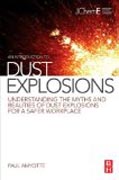
An Introduction to Dust Explosions: Understanding the Myths and Realities of Dust Explosions for a Safer Workplace
Amyotte, Paul Dr.
Preventable dust explosions continue to occur in industry in spite of significant research and practice efforts worldwide over many years. There is a need for effective understanding of the unique hazards posed by combustible dust. This book describes a number of dust explosion myths - which together cover the main source of dust explosion hazards - the reasons they exist and the corresponding scientific and engineering facts that mitigate these circumstances. An Introduction to Dust Explosions describes the main erroneous beliefs about the origin and propagation of dust explosions. It offers fact-based explanations for their occurrence and the impact of such events and provides a critical guide to managing and mitigating dust explosion risks. Designed to prevent accidents, injury, loss of life and capital damage An easy-to-read, scientifically rigorous treatment of the facts and fictions of dust explosions for those who need to - or ought to - understand dust explosions, their occurrence and consequencesEnables the management and mitigation of these critical industrial hazards INDICE: 1. INTRODUCTION: Dust Explosions - Myth or Reality? 2. MYTH NO. 1 (FUEL): Dust does not explode. 3. MYTH NO. 2 (FUEL): Dust explosions only happen in coal mines and grain elevators. 4. MYTH NO. 3 (FUEL): A lot of dust is needed to have an explosion. 5. MYTH NO. 4 (FUEL): Gas explosions are much worse than dust explosions. 6. MYTH NO. 5 (FUEL): It's up to the testing lab to specify which particle size to test. 7. MYTH NO. 6 (FUEL/IGNITION SOURCE): Any amount of suppressant is better than none. 8. MYTH NO. 7 (IGNITION SOURCE): Dusts only ignite with a high-energy ignition source. 9. MYTH NO. 8 (IGNITION SOURCE): Only dust clouds - not dust layers - will ignite. 10. MYTH NO. 9 (OXIDANT): Oxygen removal must be complete to be effective. 11. MYTH NO. 10 (OXIDANT): Taking away the oxygen makes things safe. 12. MYTH NO. 11 (MIXING): There's no problem if dust is not visible in the air. 13. MYTH NO. 12 (MIXING): Once airborne, a dust will quickly settle out of suspension. 14. MYTH NO. 13 (MIXING): Mixing is mixing; there are no degrees. 15. MYTH NO. 14 (CONFINEMENT): Venting is the only/best solution to the dust explosion problem. 16. MYTH NO. 15 (CONFINEMENT): Total confinement is required to have an explosion. 17. MYTH NO. 16 (CONFINEMENT): Confinement means four walls, a roof and a floor. 18. MYTH NO. 17 (PENTAGON): The vocabulary of dust explosions is difficult to understand 19. MYTH NO. 18 (PENTAGON): Dust explosion parameters are fundamental material properties. 20. MYTH NO. 19 (PENTAGON): It makes sense to combine explosion parameters in a single index. 21. MYTH NO. 20 (PENTAGON): It won't happen to me. 22. CONCLUSION: Dust Explosion Realities INDEX
- ISBN: 978-0-12-397007-7
- Editorial: Butterworth-Heinemann
- Encuadernacion: Rústica
- Páginas: 280
- Fecha Publicación: 03/07/2013
- Nº Volúmenes: 1
- Idioma: Inglés
